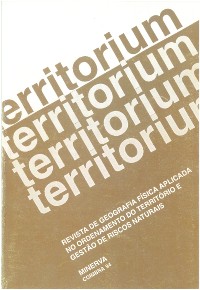Please use this identifier to cite or link to this item:
https://hdl.handle.net/10316.2/40190| Title: | Man's action and slope erosion: a case study in Tâmega Basin (1981) | Authors: | Pedrosa, António de Sousa Marques, Bernardo de Serpa |
Keywords: | Northeast of Portugal;Geomorphology;landslide;risk;human impact;Nord-est du Portugal;Géomorphologie;mouvements de terrain;risques;impactes de l'action humaine;Nordeste de Portugal;Geomorfologia;movimentos de terras;risco;impacto da actividade humana | Issue Date: | 1994 | Publisher: | Associação Portuguesa de Riscos, Prevenção e Segurança | Abstract: | No mês de Dezembro de 1981 ocorreu em Cavez, na margem esquerda do vale do Tâmega um movimento de terras que provocou uma grande perda de vidas humanas. Depois de formular algumas hipóteses, os autores observaram atentamente o local da ocorrência de modo a determinar as causas que originaram este tipo de fenómeno. As características topográficas e litológicas e as condições climáticas por si só não justificam a ocorrência deste tipo de fenómeno. De facto, os autores demonstram que, para além das condições naturais favoráveis, a actuação antrópica acentuou o impacto do fenómeno. A falta de uma correcta compreensão da dinâmica geomorfológica é, muitas vezes, responsável pelo aumento da frequência deste tipo de fenómenos. Au mois de décembre 1981, à Cavez (Arosa), sur les versants de la rive gauche du Tamega (Nord-est du Portugal), un mouvement de terrain très grave s'est déclenché. Ce mouvement, rapide, a provoqué quinze morts. En recherchant les causes du phénomène, les auteurs ont étudié la topographie, la lithologie et les conditions météorologiques dans la région. Ils ont aussi faits des enquêtes et ils ont trouvée l'action humaine com me une des causes les plus importantes du mouvement. When a catastrophic landslide occurred in a small river basin on the left bank of the Tamega valley, in the Northeast Of Portugal, which involved the sudden sliding of several tons of arable land and rocks and caused the destruction of a house and the death of fifteen people, the authors decided to carry out a careful investigation of this geomorphological phenomenon. After having formulated a number of hypotheses, they did a lot of field work in the area and carried out measurements to determine, as accurately as possible, both the real extension and the causes of the occurence of such a phenomenon in that particular place and at that particular time of the year. A series of studies enabled the authors to come the conclusion that the natural and human-induced causes had been responsible for the disaster. Disasters like this don't unfortunately constitute isolated incidents. Therefore, the authors think it is very important to study the local geomorphology carefully before any houses or the setting up of any human activity within the territory it is responsible for. |
URI: | https://hdl.handle.net/10316.2/40190 | ISSN: | 0872-8941 1647-7723 (digital) |
DOI: | 10.14195/1647-7723_1_4 | Rights: | open access |
| Appears in Collections: | Territorium |
Files in This Item:
| File | Description | Size | Format | |
|---|---|---|---|---|
| mans_action_and_slope_erosion.pdf | 4.63 MB | Adobe PDF |  |
Items in DSpace are protected by copyright, with all rights reserved, unless otherwise indicated.
